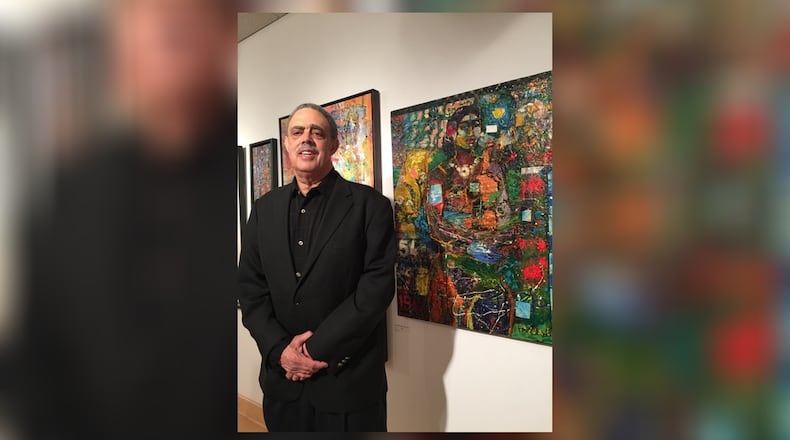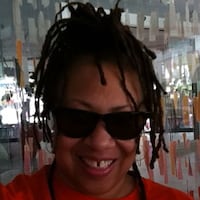Acclaimed Atlanta artist Louis Delsarte once said that painting was a form of prayer that kept him connected to God.
“There was always a spiritual tangent to what he was thinking and painting,” said his wife, Jea Delsarte. “People get on their knees to pray. Louis picks up a paintbrush and works it out on canvas.”
The Brooklyn-born painter, muralist, printmaker and poet tried to bring people together through his work, said Jea Delsarte. “He really practiced agape love,” she said. He was always listening and absorbing.
The two would have celebrated 31 years of marriage in August.
Delsarte, a father of two daughters, died May 2 from an underlying cardiac condition. He was 75.
A public memorial is planned at a later date.
He leaves a vast legacy of artwork that has been featured at the Harvard Art Museums, the High Museum of Art, Hammonds House Museum and the National Gallery of Art in Bermuda; and in private homes including that of Earl G. Graves Sr., the late philanthropist and publisher of Black Enterprise magazine.
He was a prominent fixture of the National Black Arts Festival in Atlanta and moved here in 1990 to teach at Morris Brown College, where he was a tenured professor.
Credit: Josh D. Weiss, Special to AJC
Credit: Josh D. Weiss, Special to AJC
In Atlanta, he created the mural at the Southwest Arts Center and, one of his most prominent works, the 129-foot mural, “Dreams, Visions and Change: The Dr. Martin Luther King Jr. Memorial Mural,” which was dedicated in 2010 at Peace Plaza on Auburn Avenue.
The epic mural was commissioned by the city of Atlanta to celebrate the King holiday, but "Louis would have done that mural for free," said Jea Delsarte.
The project, which had the blessing of the King family, held a special meaning to Delsarte because he believed the civil rights leader and his father embodied the same sense of spiritual excellence.
“That mural project was probably the thing he was most proud of,” she said. “Everybody was involved in the community. Black and white.”
In addition to his artwork, he was also a teacher. He taught at institutions around the nation and for the past couple of decades was an associate professor in the creative and performing arts department at Morehouse College.
He once told his wife that he wanted to be remembered foremost as a teacher.
Credit: T.W. Meyer
Credit: T.W. Meyer
“He was always fighting for the voice and traditions of those artists who were not as well remembered,” said Kevin Sipp, project supervisor for Gallery 72 in the Mayor’s Office of Cultural Affairs. “Anytime you talked to Louis about his life and his art, he would always uphold the legacies of other artists. He would talk about meeting them, their aesthetics and their influence on him.”
Delsarte always carried a sketchpad, and if someone interested him, he would draw them and then give it to the person as a gift.
“There are probably hundreds of people in Atlanta and the world who have sketches of little things that he did,” said Jea Delsarte.
He grew up in a middle-class household. Both of his parents were educators and were friends with artists and entertainers including Lena Horne, Count Basie and Langston Hughes.
His father also ran a day camp for youths that once included Black Enterprises’ Graves.
His interest in the creative arts began at a young age and was nurtured by his mother. At 7 or 8, he was taking classes at the Brooklyn Museum. He could often be found on a street corner, drawing the scenes around him.
Delsarte earned a degree in fine arts from New York’s Pratt Institute and a master’s degree in fine arts at the University of Arizona in Tucson.
His work held a certain familiarity.
No matter where one went in the African Diaspora, “you could see Louis’ people. Louis absorbed all of that ashe (a Yoruba term for life force) of people, and gave it back to us,” said longtime friend and fellow artist Arturo Lindsay, a retired professor emeritus of art and art history at Spelman College.
“He was such a phenomenal colorist,” said Lindsay. “I could give a lecture on color theory, period, just using one-quarter of one of his paintings. If Langston Hughes was the poet of the people, then Louis Delsarte is the people’s painter. He was a badass painter.”
The two met at the sprawling Stamford, Connecticut, home of Rachel Robinson, the widow of baseball great Jackie Robinson. Robinson, a devoted collector, used to throw parties for African American artists as a way to show appreciation for their work.
Delsarte and Lindsay represented a new generation of artists.
“There were cats there from the Harlem Renaissance,” said Lindsay. “Even among his peers, he was given a great deal of respect. He was recognized and appreciated as a rising star.”
Susan Ross, a member of the board of the Hammonds House Museum in Atlanta and a friend, recalled when Delsarte was painting the mural “New Hope Visions,” which now hangs in the Southwest Arts Center on New Hope Road.
“We didn’t know if we would ever get it up because he wouldn’t finish,” she recalled fondly. “He kept thinking of one more thing to put in it. There were so many layers and colors and combinations. There were layers of memory and layers of meaning and layers of history in his paintings.”
Friends describe Delsarte as a quiet and gentle man with a wry sense of humor.
“Today he would be very concerned about all the things that this COVID-19 emergency is putting us through,” Ross said. “He was quietly political and spoke through his art.”
About the Author
The Latest
Featured




